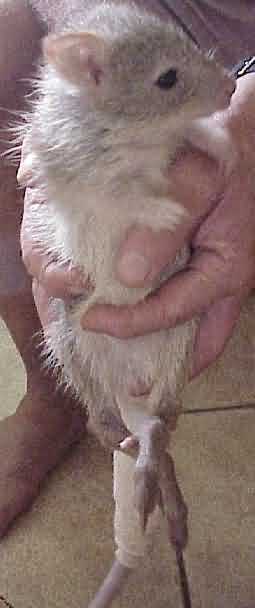
| If you find an injured animal, whatever the species, remember that it is a wild animal, probably suffering from shock and with possible injuries. The first thing to do is to quickly assess for any injuries eg broken legs/wings or bleeding and also determine what species it is, sothe appropriate food and housing can be provided when necessary. Place the animal in a quiet, warm, dark area (cardboard boxes with ventilation holes are ok, providing it is not an animal that will climb or chew out!). Remember, this is a wild animal and minimal handling is a must to avoid extra stress. If a joey, a substitute pouch and hot water bottle, and for snakes and lizards, a pillowcase tied securely at the top may be used. It is always best to seek advice from an experienced member and / or a Vet to determine what treatment is needed. If the animal does need any medication it will have to be administered by a Vet or under Vet supervision. Unfortunately, there may be times when there is nothing we can do to help the animal and it may need to be humanely destroyed. If it is treatable, we can then place the animal with a carer who has the facilities and experience where necessary to cope with it. If you do find an animal in need of help, contact us and we will do all we need to help If you find a sick or injured animal call the Fauna Rescue Whitsundays Hotline, for the Whitsunday and Bowen areas on 4947 3389. For all other areas call 1300 ANIMAL, the RSPCA hotline. They will be able to put you in contact with your closest Wildlife Care Group. 
|
 Rufous Bettong with broken tail  |
Basic First Aid Equipment
| Thick Gloves First Aid Formula (Wombaroo product) Carry cage / box Betadine Pillowcases Saline Solution Joey Pouches Cotton Buds Blankets Gauze Swabs |
Towels Tweezers Heat pad / water bottle Scissors Glucose / rescue remedy Syringes High Protein Baby Cereal Joey bottle and teats Formula One ( Wombaroo Product ) |
WILDLIFE ON OUR ROADS
At this time of the year there seem to be enormous numbers of wildlife
on the roads, which inevitably end up getting hit by cars. The mudlarks (peewees) seem to be in
excessive numbers this year, probably due to good weather during the breeding season. They seem
to be gathering on the roads to collect insects.
The wallabies are also coming to grief from venturing onto the roads. Some say that as the food sources dry up, they come to the edges of the road for the greener grass and moisture.
Another theory is that the roads are warm and they are attracted by the heat., when the weather is cold.
Or it may just be they are travelling to new areas (or old), for mates and greener pastures.
Whatever the reason you can help by beeping your horn when you see them.
At night when your driving you can also beep, just in case any wildlife is near the edge, which should scare them off in the right direction.
This is probably one of the most effective ways to scare them off the roads.
If anyone has any other tried & true methods please let us know.
Do the roo shoos really work??
The wallabies are also coming to grief from venturing onto the roads. Some say that as the food sources dry up, they come to the edges of the road for the greener grass and moisture.
Another theory is that the roads are warm and they are attracted by the heat., when the weather is cold.
Or it may just be they are travelling to new areas (or old), for mates and greener pastures.
Whatever the reason you can help by beeping your horn when you see them.
At night when your driving you can also beep, just in case any wildlife is near the edge, which should scare them off in the right direction.
This is probably one of the most effective ways to scare them off the roads.
If anyone has any other tried & true methods please let us know.
Do the roo shoos really work??